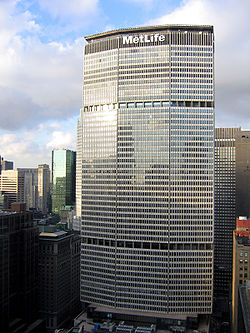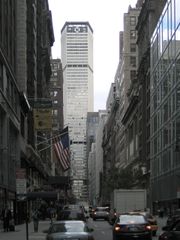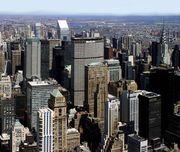MetLife Building
| MetLife Building | |
|---|---|
 |
|
| General information | |
| Location | New York, New York USA |
| Status | Complete |
| Constructed | 1963 |
| Use | Office |
| Height | |
| Roof | 808 ft (246.6 m) |
| Technical details | |
| Floor count | 59 |
| Floor area | 3,140,000 sq ft (292,000 m2) |
| Elevators | 23 |
| Companies involved | |
| Architect(s) | Emery Roth & Sons |
| Structural engineer | The Office of James Ruderman |
The MetLife Building, originally called the Pan Am Building, is a skyscraper located at 200 Park Avenue in New York City.
Contents |
History
The MetLife Building (then Pan Am Building) was the largest commercial office building in the world when it opened on March 7, 1963.[1] It is a recognizable part of the Manhattan skyline and one of the fifty tallest buildings in the United States.
Pan American World Airways was the building's owner for many years. Its logotype was depicted on a sign that was placed on the north and south faces and its globe logo was depicted on a sign that was placed on the east and west faces. The MetLife Building was the last tall tower erected in New York City before laws were enacted that prevented placing corporate logos and names on the tops of buildings.[2]
Pan Am originally had 15 floors in the Pan Am Building. Metropolitan Life Insurance Company bought the Pan Am Building from Pan Am in 1981; Pan Am's headquarters remained in the building. In 1991 Pan Am had 4 floors left; during that year Pan Am moved its headquarters to Miami. Shortly afterwards the airline ceased operations. On Thursday September 3, 1992, MetLife announced that it would remove Pan Am signage from the building. Robert G. Schwartz, the chairman, chief executive, and president of MetLife, said that the company decided to remove the Pan Am sign since Pan Am ceased operations. At the time MetLife was headquartered in the Metropolitan Life Insurance Company Tower.[3]
In 2005, MetLife sold the building for $1.72 billion, the record price at the time for an office building in the U.S. The buyer was a joint venture of Tishman Speyer Properties, the New York City Employees' Retirement System, and the New York City Teachers' Retirement System.[4]
Helicopter service
The building previously provided helicopter service to John F. Kennedy International Airport, a seven-minute flight that left from the rooftop helipad. This service was offered from December 21, 1965 to February 18, 1968 by New York Airways and for a few months in 1977. It ended after a major accident that killed five people.[5][6]
On May 16, 1977, about one minute after a Sikorsky S-61L landed and its 20 passengers disembarked, the right front landing gear collapsed, causing the aircraft to topple onto its side with the rotors still turning. One of the five 20-foot blades broke off and flew into a crowd of passengers waiting to board. Three men were killed instantly and another man died later in hospital. The blade sailed over the side of the building and killed a pedestrian on the corner of Madison Avenue and 43rd Street. Two other people were seriously injured.[7][8]
Film director Michael Findlay was named in press reports as being one of the three men on the roof to be killed instantly when "literally cut to pieces." [9]
Suicide
An incident occurred with the suicide of Eli M. Black (the father of Leon Black) on February 3, 1975. The CEO of United Brands Company (now Chiquita Brands International) used his briefcase to shatter an external window and then jumped out of the forty-fourth story window to his death on Park Avenue.
Architecture

Designed by Emery Roth & Sons with the assistance of Walter Gropius and Pietro Belluschi, the Pan Am Building is an example of an International style skyscraper. It is purely commercial in design with large floors, simple massing, and an absence of ornamentation inside or out. It has been popular with tenants, not least because of its location next to Grand Central Terminal.
In 1987, the lifestyle periodical New York revealed in a poll that MetLife—then Pan Am—was the building that New Yorkers would most like to see demolished. Perhaps contributing to the hatred of the building is the fact that it is so visible. Situated behind Grand Central Terminal outside of the grid, the building, which would have otherwise been tucked away into the city, is left totally exposed and contrasted with the other buildings around it, most notably the New York Central Building, which is now called the Helmsley Building. Today the building is one of the most recognizable skyscrapers in the City.
Many of the most influential architects of the twentieth century have commended the MetLife Building since its completion. With a shape similar to that of Pirelli Tower in Milan, MetLife is subtle while unique in its lozenge shape, in effect referencing its monumental position. Set apart from many of its contemporaries, MetLife has a heavy pre-cast facade that might have appealed to those looking for a historicist design. The importance of this design and the stress placed on its subtleties may be clearer after a close look at both Gropius's other tall building projects, such as the Chicago Tribune Tower competition.
The Portland House tower in Westminster, London has a near identical shape (identical in cross section) but is finished with a different color. It was built at the same time as the MetLife Building.
Statistics

- Height: 808 ft (246.6 m)
- Floors:59 (above ground)
- Floor space: 3.14 million ft² (307,000 m²)
Tenants
In addition to being the official headquarters of the Metropolitan Life Insurance Company, the MetLife Building houses a number of other major firms, including the headquarters of Dreyfus Corporation, the largest office of Greenberg Traurig, and the New York offices of Mishcon de Reya, Barclays Capital, DnB NOR, CB Richard Ellis, Gibson, Dunn & Crutcher, Hunton & Williams, Computer Sciences Corporation, Winston & Strawn & Lend Lease Corporation on Level 9.
The building's most famous "residents" are a pair of peregrine falcons nicknamed Lois and Clark after two of the main characters in the Superman film series, which nest there and feed on pigeons.
MetLife Building in popular culture
As a prominent New York landmark, the Metlife Building has been featured in the plots of several films, including Coogan's Bluff in which Clint Eastwood's character arrives in city by helicopter atop the building. The 1968 Paramount film Only When I Larf has the female lead, Alexandra Stewart entering the Pan Am building and traveling by helicopter from the rooftop pad. The building appears with the old "Pan Am" sign in important establishing scenes of Catch Me if You Can whose protagonist poses as a Pan Am Pilot. It is also featured in the movie Down with Love and as a backdrop in The French Connection.
The building also appears in lyrics and music videos set in New York. Yves Montand sang "Come Back to Me" on top of the Pan Am Building in the 1970 Barbra Streisand musical On a Clear Day You Can See Forever. Joni Mitchell has the line "A helicopter lands on the Pan-Am roof like a dragonfly on a tomb" in her song "Harry's House" on the The Hissing of Summer Lawns album.
In the film Charlie and the Chocolate Factory the Metlife Building is shown in the New York City screenshot when the film shows how the Golden Ticket contest is in process throughout the world.
This prominence continues into video games Grand Theft Auto IV features the "GetaLife Building", based on the MetLife Building. The MetLife Building also appears in all three video games to the Spider-Man movies, but only the first video game features the building with the MetLife logo on the top.
Recently, the MetLife Building has become a target in disaster movies.In the 1998 film Armageddon, a meteor strikes a lower-level building with the MetLife Building in the background. In the 1998 remake of Godzilla, the building is shown after Godzilla storms the Grand Central Terminal after arriving into New York City. While the tower still stands, Godzilla evidently plows through the building, leaving behind an enormous hole. In the 2008 film Cloverfield, the building is shown near an evacuation zone. The most dramatic instance appears in 2009's Knowing, where a massive solar flare dramatically blows all of the windows out the south facade before incinerating the entire structure. In Transformers: Revenge of the Fallen, it is one of the buildings the Decepticons climbed in New York City.
See also
- Buildings and architecture of New York City
- Tallest buildings in New York City
References
- ↑ Horsley, Carter C. The MetLife Building, The Midtown Book. Accessed September 30, 2007. "When it was completed, the 2,400,000 sq ft (220,000 m2). building became the world's largest office building in bulk, a title it would lose a few years later to 55 Water Street downtown."
- ↑ Schneider, Daniel B. "F.Y.I.", The New York Times, January 5, 1997. Accessed September 30, 2007. "Q. I recall that it was 1963 when the huge Pan Am letters were put atop what is now the Met Life building and that it was 1992 when they were taken down.... A. Most of the letters and the accompanying logos did not survive removal; exceptions are in warehouses.... The letters, each about 15 feet (4.6 m) tall, and the logos -- 25-foot (7.6 m)-wide globes -- had to be cut into sections and pulled up onto the roof by technicians from Universal Unlimited, who built and installed their replacements, the Met Life signs."
- ↑ Dunlap, David W. "Final Pan Am Departure." The New York Times. Friday September 4, 1992. Retrieved on August 25, 2009.
- ↑ Ramirez, Anthony. "MetLife Sells 2nd Building, A Landmark On Park Ave." The New York Times. April 2, 2005. Retrieved on August 25, 2009.
- ↑ Schneider, Daniel B. "F.Y.I.", July 25, 1999. Accessed September 30, 2007. "Q. Back in the 1960's and 70's, helicopters bound for Kennedy International Airport used to take off from a deck atop the old Pan Am Building. Why was the service halted? A. As many as 360 helicopter flights a day were planned by New York Airways after the 59-story Pan Am building was completed in 1963, but a bitter public outcry delayed the first few flights until Dec. 21, 1965.... The operation proved unprofitable, however, since the helicopters carried an average of only eight passengers, and the heliport, which had cost $1 million to build, closed in 1968.... After another round of hearings -- and renewed protests -- flights resumed in February 1977. Three months later, the landing gear on one of the Sikorsky S-61 helicopters collapsed while passengers were boarding, flipping it on its side and sending a 20-foot rotor blade skidding across the roof and over the west parapet wall.... Within hours, the heliport was closed indefinitely."
- ↑ Hudson, Edward. "Helicopter Service From Roof Of Pan Am Building Suspended; PAN AM SUSPENDS COPTER SERVICES", The New York Times, February 19, 1968. Accessed September 30, 2007. "Helicopter operations from the 59-story roof of the Pan Am Building were suspended last night as a result of a dispute over the future financial support of the operation by Pan American World Airways."
- ↑ NTSB. Aircraft Accident Report - New York Airways, Inc., Sikorsky S-61L, N619PA Pan Am Building Heliport, New York, New York, May 16, 1977. (PDF)
- ↑ UPI. Helicopter Crash Kills Five. Beaver County (Pa.) Times: Tuesday, 17 May 1977, A-13.
- ↑ AP. Five Dead in Helicopter Crash. The Fort Scott Tribune: Tuesday, 17 May 1977, page 1.